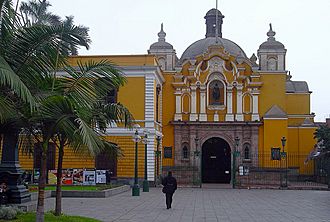Casona of the National University of San Marcos facts for kids
Quick facts for kids Casona de San Marcos |
|
|---|---|

View of the building's chapel from the park
|
|
| General information | |
| Type | Institution, cultural centre |
| Architectural style | Baroque, Rococo |
| Location | Lima |
| Address | Av. Nicolás de Piérola 1222, University Park, Lima |
| Country | Peru |
| Opened | 1605 |
| Owner | University of San Marcos |
| UNESCO World Heritage Site | |
| Criteria | Cultural: iv |
| Inscription | 1988 (12th Session) |
| Area | 259.36 ha |
| Buffer zone | 766.70 ha |
The Casona of the National University of San Marcos is a large, historic building in Lima, Peru. It's also known as the Cultural Centre of San Marcos (CCSM). This amazing building is home to the cultural centre of the National University of San Marcos.
The Casona and the nearby University Park are part of the Historic Center of Lima. This area was recognized as a World Heritage Site by UNESCO in 1988. It's one of the best-preserved colonial buildings in Lima.
This building used to be a special school for Jesuit priests. Later, it became the main home for the University of San Marcos from 1875 to 1966. Today, it's a hub for art and culture. It has a theatre (the University Theatre or TUSM), a library, and groups for ballet, folklore, music, and film. It also houses two museums: the Museum of Art (MASM) and the Museum of Archaeology and Anthropology (MAA). It's one of the oldest and most important non-religious historical buildings in Lima.
History of the Casona
How the Building Started
The story of the Casona began in 1605. A rich Spanish person named Antonio Correa Ureña gave money to build a special school. This school was for new members of the Society of Jesus, also known as Jesuits. It was called the Novitiate of San Antonio Abad.
The original building was much bigger than what you see today. It was five or six times larger!
Rebuilding After an Earthquake
In 1746, a big earthquake partly destroyed the building. But the Jesuits rebuilt it with a new design. This new design is mostly what we see today.
After the Jesuits were asked to leave in 1767, the Viceroy of Peru, Manuel de Amat y Junyent, started a new school there. It was called the Real Convictorio de San Carlos, named after King Charles III of Spain. This school became very important from the late 1700s to the 1800s.
Becoming Part of the University
After Peru became independent in 1821, the San Carlos school continued its work. It was almost separate from the University of San Marcos. But in 1867, a law brought the San Carlos school into the University of San Marcos.
The building remained very important for the university and for Lima. In 1966, another earthquake damaged the Casona. Because of this, the university's main offices moved to the new University City. The Casona was then changed to host the university's cultural activities.
Restoration and Modern Use
In 1989, the University of San Marcos, the Spanish Agency for International Development Cooperation, and the National Institute of Culture worked together. They signed an agreement to restore the Casona. The goal was to use it for culture, research, and art. Spain provided money and technical help for the restoration.
Today, the Casona is the university's cultural centre. It offers cultural courses, art shows, and is home to several university museums and research groups. Inside, there's the Hall of Degrees, where important ceremonies happen. There are also other beautiful halls and courtyards.
Inside the Casona
Important Halls
Chapel of Nuestra Señora de Loreto
This chapel is also called the Hall of Degrees of Literature. It's located between two courtyards: Literature and Jasmines. It's one of the most beautiful parts of the old Casona.
The ceiling of the chapel has thirteen lovely paintings from the mid-1700s. These paintings show important saints and thinkers of the Church.
General Hall
The General Hall is a large room with wooden stands and galleries. It dates back to the late 1700s. This room was once used for debates. Today, it hosts the most important university ceremonies, like graduations and special meetings.
Beautiful Courtyards
In the early 1900s, the Casona had five main courtyards.
The Courtyard of los Maestros was the main one. It has a carved sculpture in the middle. This sculpture has seen many historical events and is a symbol of the university. You can even see it on the 20 soles banknotes!
Other courtyards included the Courtyard of los Naranjos, the Courtyard of los Chicos, and the Courtyard of los Jasmines. Each courtyard was used by different parts of the university.
University Museums
Museum of Archaeology and Anthropology
The Museum of Archaeology and Anthropology (MAA) is the university's museum about ancient cultures and people. It used to be called the Museum of Archeology and Ethnology.
It was started on October 21, 1919. It has a collection of ancient stone tools, pottery, and other old items. Its first director was a famous archaeologist named Dr. Julio C. Tello. In 2023, the museum added two new rooms to its permanent collection.
Museum of Art
The Museum of Art (MASM) is the university's art museum. A famous Peruvian archaeologist and historian, Rebeca Carrión Cachot, once worked there.
The museum's history began on September 27, 1951, as the Museum of Pictorial Reproductions. Later, in 1970, the Museum of Art and History was added. On October 23, 1996, these two museums joined to become the current Museum of Art.
Its collection includes four main types of art: popular art, portraits, modern art, and paintings by farmers. The portraits include paintings of important university staff and former students.
University Theatre
The San Marcos University Theatre (TUSM) is the university's own theatre group. It was started on September 4, 1946, by a group of students.
Many different directors have led the theatre group since it began.
| № | Director | Period |
|---|---|---|
| 1 | Mario Rivera | 1946 |
| 2 | Humberto Napurí Jordán | 1956 |
| 3 | Guillermo Ugarte Chamorro | 1958–1988 |
| 4 | Eduardo Hopkins | 1988–1992 |
| 5 | Hernando Cortés | 1992–1997 |
| 6 | Walter Zambrano | 1998–2001 |
| 7 | Ana Zavala | 2002–2007 |
| 8 | Luis Ramírez | 2007 |
| 9 | Gabriela Velásquez | 2007 |
| 10 | Ernesto Ráez Mendiola | 2008 |
| 11 | Mario Delgado | 2010 |
| 12 | Augusto Cáceres Álvarez | 2011–present |
Images for kids
-
A wide view of the building and its park. You can see the German Tower and other monuments.
See also
 In Spanish: Casona de la Universidad Nacional Mayor de San Marcos para niños
In Spanish: Casona de la Universidad Nacional Mayor de San Marcos para niños
- National University of San Marcos
- University City of the National University of San Marcos
- Royal College of the University of San Marcos









